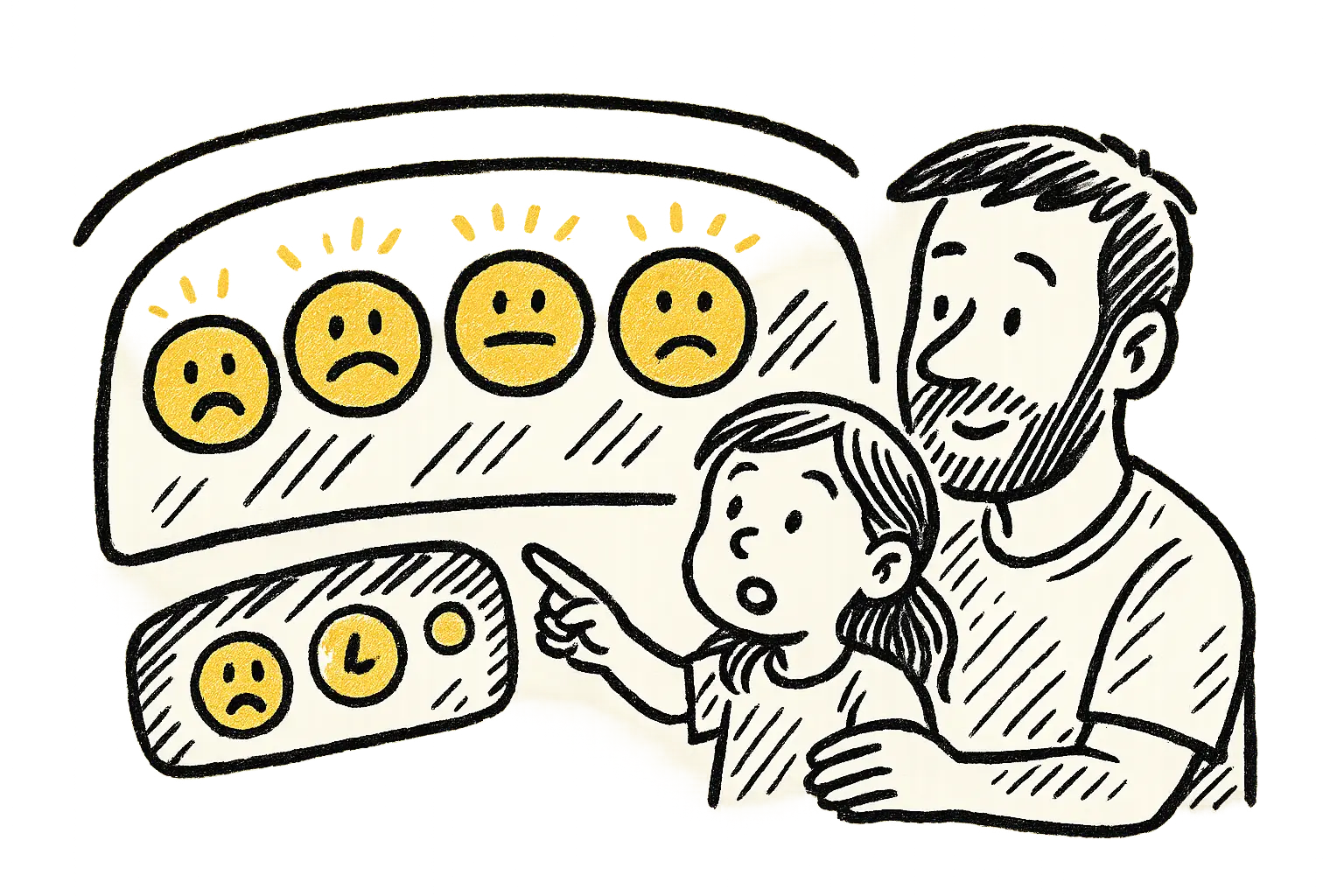Teaching My Daughter to Read Her Emotional Dashboard

Dashboard Lights: Our New Emotional Metaphor
When my daughter melts down, I remind myself: emotions aren’t emergencies. They’re more like the dashboard lights on a car—little signals that something needs attention, not immediate panic.
Some dashboard lights mean "pull over now." Most just whisper, "keep an eye on this." If I slam on the brakes every single time something flashes, we’ll never get anywhere. And if I ignore every warning, eventually something important is going to break down.
Why Naming Feelings Works
When she’s upset, we slow down together and ask, “What’s going on inside?” Sadness? Frustration? Embarrassment? Just naming the feeling changes the whole temperature. I used to think labeling feelings was a pop-psych fad—until I saw UCLA research showing that putting feelings into words calms our brain’s alarm system and helps the thinking part take over (Lieberman et al., 2007). In our house, sometimes it really does help her body settle down.
Detective Work: Tracing Emotions
We play detective by tracing the feeling to its source. “What were you thinking about right before this showed up?” Sometimes she can connect the dots—like, “I felt left out when my friend didn’t save me a seat.” That little moment of reflection isn’t magic, but it builds emotional awareness. And psychologists say that’s a big step toward resilience.
Coaching vs. Comfort: Finding the Balance
The dashboard metaphor helps us both see feelings as information—not character flaws, not disasters.
- It makes emotions less scary.
- It separates having an emotion from being that emotion (she isn’t “an angry person”—she’s just got the anger light flickering).
- It helps us talk about big feelings without panicking.
Some days, I use emotion coaching: naming feelings, talking through them. Gottman’s research in the 1990s backs this up—kids whose parents make space for emotions are better at calming down, making friends, and managing stress (Gottman et al., 1996). But not every moment deserves a detective. Sometimes, she just needs to cry about the internet being down, or wail after her sister won’t play. No big analysis required—just me, sitting near her, letting the storm pass.
Experts call this mix co-regulation (helping kids calm) and self-regulation (letting them try for themselves). It’s a balance I’m still learning. If I rush to “fix” every feeling, she loses the chance to build those emotional muscles herself (Morris et al., 2007).
Making Room for Real Meltdowns
Some things I’m working on:
- Slowing down before explaining, so she’s calm enough for it to stick (Gottman et al., 1996).
- Modeling my own emotions—actually naming them out loud.
- Not flipping into “mechanic mode” too fast.
- Making sure the whole crew (me, her mom, grandparents) uses the same language so she isn’t confused by mixed signals (Denham et al., 2007).
- Making space for unstructured, unexamined feelings—sometimes tears just need to happen.
Different Kids, Different Dashboards
Not every family or child will vibe with dashboards. Some cultures encourage loud expression; others value quiet restraint. For some kids, weather metaphors or Rumi’s “Guest House” work better. Whatever the metaphor, the point is helping kids see feelings as signals—not permanent traits.
And neurodiversity matters. Kids with ADHD or autism feel emotions more intensely and sometimes all at once. For them, letting the storm come and go is often better than trying to clamp down fast. It’s more about creating safety, staying present, and reflecting afterwards (Barkley, 2015; Shaw et al., 2014).
Growing Up, Growing Skills
How I help shifts as she grows:
- Little kids: simple feeling words + comfort items.
- School-age: metaphors and reflection.
- Tweens/teens: journaling, mindfulness, and chats with friends.
What works at five can frustrate at twelve.
Bringing It All Together: Takeaways for Parents and Kids
What I hope she learns? That none of her feelings mean she’s broken. They’re just signals. She doesn’t have to fight every feeling or believe every story her mind tells when she’s upset. Naming emotions can help; letting them drift away is fine too. Feelings aren’t roadblocks—they’re part of the journey. Learning to read the dashboard, or notice storms as they pass, is how we keep moving forward.
Want More? Get Everyday Phrases to Talk Through Big Feelings
If this approach to feelings resonates with you, I created a free “Everyday Phrases to Talk Through Big Feelings” guide for subscribers—packed with simple ways to put these ideas into practice during real-life moments. Join our community to access it now.
References
- Barkley, R. A. (2015). Attention-Deficit Hyperactivity Disorder: A Handbook for Diagnosis and Treatment. Guilford Press.
- Denham, S. A., Bassett, H. H., & Wyatt, T. M. (2007). The socialization of emotional competence. Handbook of Socialization, 614–637.
- Gottman, J. M., Katz, L. F., & Hooven, C. (1996). Parental meta-emotion philosophy and the emotional life of families. Journal of Family Psychology, 10(3), 243–268.
- Lieberman, M. D., et al. (2007). Putting feelings into words: Affect labeling disrupts amygdala activity. Psychological Science, 18(5), 421–428.
- Morris, A. S., Silk, J. S., Steinberg, L., Myers, S. S., & Robinson, L. R. (2007). The role of the family context in the development of emotion regulation. Social Development, 16(2), 361–388.
- Shaw, P., Stringaris, A., Nigg, J., & Leibenluft, E. (2014). Emotion dysregulation in attention deficit hyperactivity disorder. American Journal of Psychiatry, 171(3), 276–293.


Member discussion